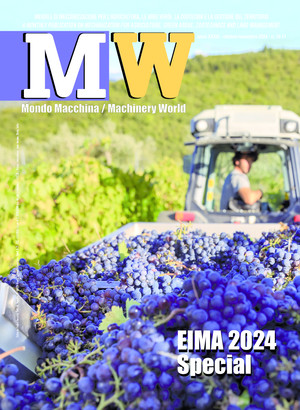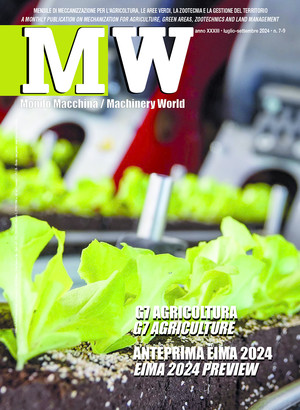
All technologies for water management
Drought and heat do not let go. Only with cutting-edge technologies and the reduction of losses can we truly safeguard water resources. The most innovative systems at EIMA Idrotech
room for interpretation. The heat is raging. Accompanied in many areas of the planet and Italy by a record drought. The numbers say it: according to the European climate programme Copernicus, the month of June was the warmest ever recorded globally.
Not an exception, given that the Copernicus Climate Change Service itself highlights that this was the thirteenth consecutive month in which monthly heat records were broken. July broke that pattern: it was 'only' the second warmest on record since 1940, just slightly less hot than July 2023.
Good news? Not at all. Even without monthly records, in July the Earth experienced its two warmest days on record: on July 22 and 23 the daily global average temperature reached 17.16°C and 17.15°C, respectively.
And so it looks increasingly likely that 2024 will be the hottest year on record. So much so that Carlo Buontempo, the Italian who directs the Service, speaks of alarming data and remarks “we are already in unexplored territory, something more than a statistical oddity, which highlights a broad and continuous change in our climate”. Something that is “inevitable as long as humanity continues to add heat-trapping gases to the atmosphere.”
On the same wavelength is Samantha Burgess, Deputy Director of Copernicus: “Our climate continues to warm. The devastating effects of climate change began well before 2023 and will continue until global greenhouse gas emissions reach net zero."
A climate crisis and a global warming that for Copernicus represents almost a point of no return, so much so that it predicts new records for the world in the short and medium term.
Rainfall at the low point
And on the water front there is little to be cheerful about. Many areas of the planet are now structurally deficient and are heading towards desertification. But even in Italy, 2024 is a red alert for at least two thirds of the territory, all of Central and Southern Italy, considering that at least this year the spring rains have allowed the North to manage water resources a little less critically.
A scorching June, July and much of August have aggravated the drought, which has drastically reduced agricultural productivity and restricted the productivity of livestock farms, which were short of fodder and water rationed.
Adding up the winters of 2021-2024, the entire peninsula has seen a reduction in precipitation. More pronounced in the South and in the Islands which paid higher duties with drops of 2.3% and 5.7% respectively compared to the previous thirty years.
The words of Francesco Vincenzi, president of the National Association of Consortia for the Management and Protection of Land and Irrigation Waters (Anbi), outline a more than worrying picture. In Puglia, in addition to the collapse of durum wheat yields and the halving of many fruit and vegetable productions, there is a concrete risk of seeing the Foggia plain dry up, as well as large portions of the Salento territory. In Abruzzo, water in the basins is increasingly scarce and the region has faced an unprecedented water crisis. In Sicily, rainfall over the last 12 months has been similar to that recorded during the great drought of 2002. Most of the island's 29 basins have run out of usable water, many municipalities have rationed water and the risk of permanent damage to citrus groves is significant. Situations of “danger”, with reductions in water supply, have also occurred for the reservoirs in Sardinia.
And the problem of leaks and neglect returns, with a less than positive recurrence, with dams that do not retain water and distribution networks that are like sieves. A few numbers reflect the current national situation: France is able to retain approximately 37% of the rainwater that falls on the country, Spain 28%, Italy is stuck at 11%.
Against this backdrop, the proposal to invest heavily in a national plan for reservoirs resurfaces, a request that has been made for at least five years and which does not seem to have had much momentum.
Keyword: savings
While we wait to work on the very large, we can hopefully already intervene on the very small. Saving with the support of precision agriculture and research into highly innovative materials and techniques. We have already talked about it in this magazine but it is worth highlighting that in such a scenario the contribution of technology can be strategic and, if not solve the problems entirely, significantly limit them.
By working on soil data, crop needs and combining these numbers with seasonal trends, it is possible to accurately dose irrigation interventions, fertiliser inputs and often even defense interventions. With evident reductions in the consumption of technical means, environmental impact and, not least, cultivation costs. The case histories are many. From fully automated irrigation systems, powered by solar energy systems, self-sufficient even in areas not reached by the electricity grid. To platforms that integrate intelligent irrigation systems for the management of irrigation interventions with remote control systems for the progress of insect captures, also providing a forecast of the development of their population capable of directing the farmer towards the best time of intervention.
This is the case of the Teti project of the Italian Space Agency and Crea-Irea which, thanks to the synergic use of satellite images Sentinel-1 and 2 of the European Copernicus program, Cosmo-SkyMed, Saocom and Prisma, is able to produce maps of surface soil humidity, to create a hydrological balance on a daily scale and to propose artificial intelligence algorithms for the spatial modelling and forecasting of hydro-meteorological parameters. In practice, to carry out targeted and operational irrigation advice.
Having said that precision irrigation still has a long way to go, it should be noted that there are already numerous field experiences that have led to water savings of between 30 and 40%. From the University of Bologna's study on the yellow kiwi of Ravenna to the Canova company's initiative on maize in Lombardy, passing through the Wappfruit on apple trees in Piedmont.
Another solution is sub-irrigation with Ultra Low Drip Irrigation systems (low flow distribution of dispensers), capable of distributing even just 0.6-0.7 l/h. This involves plant rainfall of between 0.4 and 0.8 mm/h and extended operating times, up to 10 hours a day. The slow release of water corresponds to the plant's instantaneous water consumption during the day: water losses due to deep percolation are practically eliminated, nutrient leaching is reduced and runoff phenomena are avoided. Again, according to data collected within the Water4agrifood project, in addition to greater irrigation efficiency, water savings are in the order of 30%.
Then there is the big chapter of new generation materials. As an example, we can mention the joint Italian-Chinese project (Crea-Caas) for the development of highly reflective photoselective plastic films for mulching, capable of guaranteeing real savings in water and, consequently, energy and chemical products, and thus a clear contribution to integrated pest management. The physical mechanism of operation is based on the high condensation activity of the water under the sheet, by virtue of a notable variation in temperature between the film and the ground, determined by the low heating of the sheet itself due to a high reflectivity of solar radiation. A system that is expected to save between 25 and 30% of water compared to traditional plastic films.
EIMA Idrotech, more than an opportunity
In such a context, it is necessary to stay up to date, updated and informed. Since there are many manufacturers involved in irrigation, new technologies, precision systems. This is confirmed by Eima International (6-10 November in Bologna) which, among the halls, registers a full house for the Eima Idrotech event. In the 10,500 m2 dedicated to this sector (hall 21, 22 and 23) will accommodate 240 exhibitors. Of these, 130 came from across the border (55%), a figure that is far from irrelevant since this is the show with the highest percentage of foreign exhibitors of the entire Eima International, which promises to be a record-breaking event once again.
In the 1950s, the extraordinary Quartetto Cetra was making a splash with its “Donna, tutto si fa per te” (Woman, everything is done for you). It wouldn't be bad to do it for water today.








